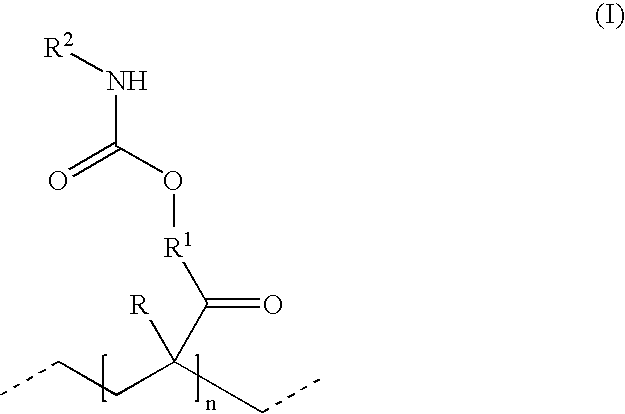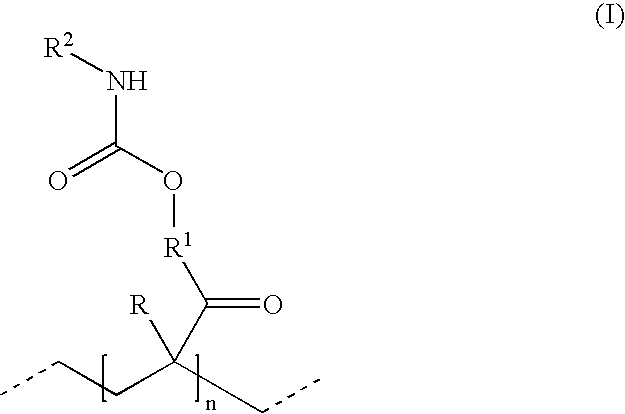Hydrophillic polyisocyanate mixtures
- Summary
- Abstract
- Description
- Claims
- Application Information
AI Technical Summary
Benefits of technology
Problems solved by technology
Method used
Image
Examples
example 1
Inventive; Emulsifier C1
[0112] 900 g (4.37 eq) of the polyacrylate-modified polyisocyanate A (I) were introduced as an initial charge at 100° C. under dry nitrogen and with stirring, admixed over the course of 30 minutes with 100 g (0.29 eq) of a monofunctional polyethylene oxide polyether prepared starting from methanol and having an average molecular weight of 350, and stirred further at this temperature until, after about 2 h, the NCO content of the mixture had fallen to the figure of 17.1% corresponding to complete urethanization. After cooling to room temperature, the characteristic data for the resultant hydrophilic polyisocyanate mixture of the invention were as follows:
Solids content: 100%
NCO content: 17.1%
Viscosity (23° C.): 14 800 mPas
example 2
Inventive; Emulsifier C1
[0113] 900 g (4.52 eq) of the polyacrylate-modified polyisocyanate A (II) were introduced as an initial charge at 100° C. under dry nitrogen and with stirring, admixed over the course of 30 minutes with 100 g (0.20 eq) of a monofunctional polyethylene oxide polyether prepared starting from methanol and having an average molecular weight of 500, and stirred further at this temperature until, after about 2 h, the NCO content of the mixture had fallen to the figure of 18.2% corresponding to complete urethanization. After cooling to room temperature, the characteristic data for the resultant hydrophilic polyisocyanate mixture of the invention were as follows:
Solids content: 100%
NCO content: 18.2%
Viscosity (23° C.): 4700 mPas
example 3
Inventive; Emulsifier C1
[0114] 900 g (4.52 eq) of the polyacrylate-modified polyisocyanate A (II) were introduced as an initial charge at 100° C. under dry nitrogen and with stirring, admixed over the course of 30 minutes with 100 g (0.20 eq) of the polyether alcohol described in Example 2, and stirred further at this temperature until, after about 2 h, the NCO content of the mixture had fallen to the figure of 18.2% corresponding to complete urethanization. After addition of 0.01 g of zinc(II) 2-ethyl-1-hexanoate as allophanatization catalyst, the heat of reaction liberated caused the temperature of the reaction mixture to rise to 105° C. After the exothermic heat had subsided, approximately 30 minutes after addition of the catalyst, the reaction was discontinued by addition of 0.01 g of benzoyl chloride and the reaction mixture was cooled to room temperature. This gave a hydrophilic polyisocyanate mixture of the invention having the following characteristic data:
Solids content:...
PUM
| Property | Measurement | Unit |
|---|---|---|
| Temperature | aaaaa | aaaaa |
| Fraction | aaaaa | aaaaa |
| Percent by mass | aaaaa | aaaaa |
Abstract
Description
Claims
Application Information
 Login to View More
Login to View More - Generate Ideas
- Intellectual Property
- Life Sciences
- Materials
- Tech Scout
- Unparalleled Data Quality
- Higher Quality Content
- 60% Fewer Hallucinations
Browse by: Latest US Patents, China's latest patents, Technical Efficacy Thesaurus, Application Domain, Technology Topic, Popular Technical Reports.
© 2025 PatSnap. All rights reserved.Legal|Privacy policy|Modern Slavery Act Transparency Statement|Sitemap|About US| Contact US: help@patsnap.com



